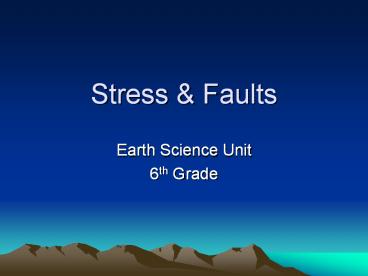Stress - PowerPoint PPT Presentation
1 / 12
Title: Stress
1
Stress Faults
- Earth Science Unit
- 6th Grade
2
Stress
- Stress is a force that acts on rock to change its
shape or volume. - Because stress is a force it adds energy to the
rock. The energy is stored in the rock until the
rock either breaks or changes shape.
3
Three Types of Stress
- Shearing Stress that pushes a mass of rocks in
two opposite directions. Shearing occurs where
two plates are moving in opposite directions. - Tension Stress that pulls on the crust,
stretching rock so that it becomes thinner in the
middle. Tension occurs where two plates are
moving apart. - Compression Stress that squeezes rock until it
folds or breaks. Compression occurs when one
plate pushes into another plate.
4
The effect of stress on the crust.
- Deformation is any change to the Earths shape
or volume caused by stress. - This change can take the form of Mountain
Building, Earthquakes, Volcanoes, Canyons and
Trenches, Changes in River Beds, Tsunamis, etc.
All of these affect the shape and volume of the
crust of the Earth.
5
Stress Earthquake Clip
6
Faults
- Faults are breaks in the Earths crust where
slabs of rock slip past each other. - The rock on both sides of the fault can move up,
down, or sideways. - Faults usually occur along plate boundaries.
- There are three main types of Faults.
Strike-Slip, Normal, and Reverse.
7
Types of Faults
- Strike-Slip Fault A fault in which the rocks on
either side of the fault slip past each other
sideways with little up-or-down motion.
8
Strike-Slip Fault Clip
9
Type of Faults (cont.)
- Normal Fault A fault that is at an angle, so
one block of rock lies above the fault while the
other block of rock lies below the fault.
10
Types of Faults (cont.)
- Reverse Fault A fault having the same structure
as a normal fault but the blocks are moving in
different directions.
11
Mountain Building Along Faults
- Over millions of years normal or reverse faults
can uplift blocks of rock that form mountains. - When two plates converge, the resulting stress is
released in the form of uplifts or folding.
12
Normal or Reverse Fault Clip































